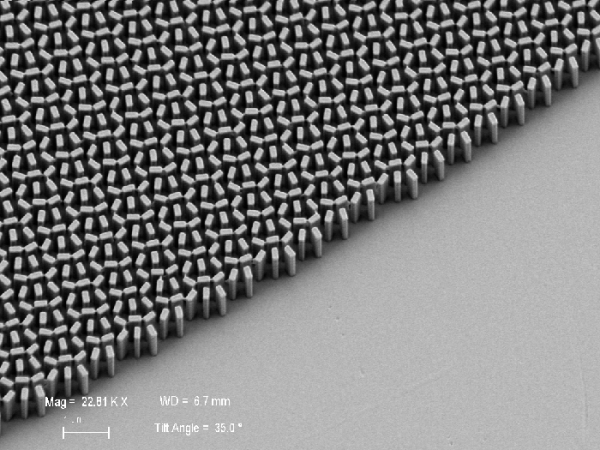This Ultra Thin Flat Metalens Can Replace Bulky Camera, Microscope, Telescope Lenses
| Ana Verayo | | Jun 05, 2016 05:19 AM EDT |
(Photo : Capasso Lab) Scanning electron microscope micrograph of the fabricated meta-lens. The lens consists of titanium dioxide nanofins on a glass substrate. Scale bar: 2 mm
Researchers have now developed the first ultra thin flat lens that can now replace bulky lenses of cameras, telescopes and microscopes that can function with the highest efficiency across the the visible light spectrum.
The curved lenses found in cameras and telescopes are usually stacked together to prevent distortions and to be able to resolve a crystal clear image, as this is the exact reason why telephoto lenses are so long and powerful microscopes are so large in size.
Like Us on Facebook
In this new study, researchers from the Harvard School of Engineering and Applied Sciences revealed the first ever planar lens that can work efficiently within the visible light spectrum which means that it can span an entire range of colors from red to blue hues.
This lens works by resolving nanoscale features that are separated by more minute distances compared to the wavelength of light passing through. This is completed by using an ultrathin array of tiny waveguides that are called metasurface that possesses the ability to bend light that is passing through it.
According to Federico Capasso of Harvard University, this is such a revolutionary technology since it works with the visible spectrum, which means that it can potentially replace all lenses in all types of devices ranging from cameras, microscopes to cellphone displays.
Researchers say that for red, blue and green light to focus in a visible light spectrum, a type of material is needed that would not absorb or even scatter light. This material should also be able to restrict and confine light inside a highly refractive index which should also be existing and being applied already in numerous industries.
By using titanium dioxide, researchers were able to utilize this common material found in paint to sunscreen, in order to build the nanoscale array of smooth, high aspect ratio nanostructures that is the major component of the metalens.
According to Mohammadreza Khorasaninejad from the Capasso Lab of the Harvard School of Engineering and Applied Sciences, the team was aiming to design a single planar lens that possesses a high numerical aperture which means that it can focus light into a single spot which is smaller than the wavelength of light.
Khorasaninejad adds, the more tightly packed that beam of light can be, the focal spot becomes ultimately smaller that potentially enhances the image resolution.
This new array designed by the team can resolve a structure so small, it is smaller than any light wavelength, at about 400 nanometers. With these scales, this metalens can provide a highly optimized focus than any existing commercial lens.
The team also plans to use this mealens for wearable optics, flexible contact lenses and powerful telescopes in space. This new study is published in the journal Science.
Tagsglass optics, metalens, ultra thin flat lens, flat camera lens, flat lens, planar optics, metalenses
©2015 Chinatopix All rights reserved. Do not reproduce without permission
EDITOR'S PICKS
-

Did the Trump administration just announce plans for a trade war with ‘hostile’ China and Russia?
-

US Senate passes Taiwan travel bill slammed by China
-

As Yan Sihong’s family grieves, here are other Chinese students who went missing abroad. Some have never been found
-

Beijing blasts Western critics who ‘smear China’ with the term sharp power
-

China Envoy Seeks to Defuse Tensions With U.S. as a Trade War Brews
-

Singapore's Deputy PM Provides Bitcoin Vote of Confidence Amid China's Blanket Bans
-

China warns investors over risks in overseas virtual currency trading
-

Chinese government most trustworthy: survey
-

Kashima Antlers On Course For Back-To-Back Titles
MOST POPULAR
LATEST NEWS
Zhou Yongkang: China's Former Security Chief Sentenced to Life in Prison

China's former Chief of the Ministry of Public Security, Zhou Yongkang, has been given a life sentence after he was found guilty of abusing his office, bribery and deliberately ... Full Article
TRENDING STORY

China Pork Prices Expected to Stabilize As The Supplies Recover

Elephone P9000 Smartphone is now on Sale on Amazon India

There's a Big Chance Cliffhangers Won't Still Be Resolved When Grey's Anatomy Season 13 Returns

Supreme Court Ruled on Samsung vs Apple Dispute for Patent Infringement

Microsoft Surface Pro 5 Rumors and Release Date: What is the Latest?










